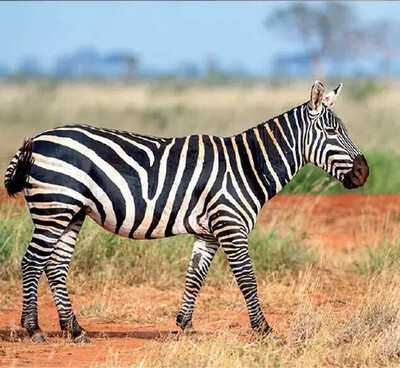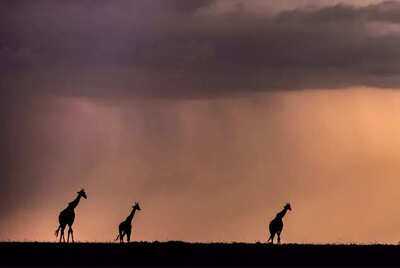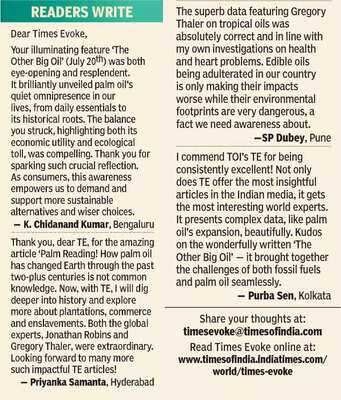Rob Nixon is Professor of English at Princeton University. Speaking to Srijana Mitra Das at Times Evoke before World Nature Conservation Day (28 July), he discusses changing ecological views:
We are seeing a world where climate science is now being denied and ‘Drill, baby, drill’ are acceptable words — has your concept of ‘slow violence’ against ecology become faster?
The pace of change is accelerating. In America, there is certainly the defunding of environmental agencies and the denial of climate science — yet, it is harder now to deny this than it was earlier and the forces trying to do so are a little less sure and vocal. However, we now have the phenomenon of a clutch of billionaires emerging from places like Silicon Valley with an idea of the ‘techno-fix’ — this includes huge plans like solar geoengineering, diverse grand megaprojects of reorganising the environment technologically. In my view, these are almost surrogate ways of climate denial. These people accept climate science but the only solutions they offer are techno-determinism, driven by profit and hostile to regulations. These projects don’t ever focus on reducing emissions — the approach assumes the only solution will be technological as opposed to new forms of governance, civic action, etc. Money can be earned from these initiatives — these groups thus are not climate denialists but once you start discussing neoliberal politics, the need for regulation and redistribution of opportunity, they oppose those. So, the techno-utopians are, in a sense, playing for Team Climate Denial as they are not interested in reducing emissions or ensuring environmental justice .

You write of the ‘ environmentalism of the poor ’ — can you describe that? This is an effort to emphasise the poor, both urban and rural, have environmental values and make ecological choices. As ecosystems get degraded, the poor are most vulnerable to making difficult choices between protecting the environment and surviving threatened circumstances. For a long time, it was assumed the automatic spokesperson for nature would be a white person from the Global North — today, there is a bigger chorus of voices, including people who have direct environmental experience. This helps reconcile issues like food and water security with conservation in a very different way from having only the voices of people in Washington, Geneva or London. Their decisions don’t take into account the fact of sharing land with other creatures.

You write of South Africa as well — was access to nature itself divided on a racial basis during the apartheid era?
Yes. In terms of the whole edifice of conservation, particularly in southern and eastern Africa where the largest populations of white colonialists lived, there was ‘fortress conservation’ or the protection of animals at the expense of locals. There was racial segregation and exclusion in terms of black access to natural spaces — for many black Africans, it seemed like white conservationists liked animals more than them.

A big shift taking place now — there is much more respect for rural Africans as possessing environmental knowledge. There is growing recognition of how they have lived for centuries with the land and ecosystems and developed reservoirs of knowledge which old-style colonial conservation never respected, nor engaged with. The idea was conservation did not come ‘naturally’ to the colonised. Fortunately, there has been a change in that now. Yet, the long history was extremely segregationist and discriminatory — if a white person killed animals, they were a ‘hunter’, but if a black person did the same, they were a ‘poacher’. An identical activity was given different designations according to the race of the person carrying the weapon.
Did colonial control also impact nonhuman species in South Africa? The big driver for tourism — and thus, for conservation, which attempted to make wildlife into a touristic money-spinner — in southern and eastern Africa, which includes South Africa, Botswana, Zimbabwe, Namibia, Kenya, Tanzania and Uganda, was charismatic megafauna. So, most conservation focus was on elephants, lions, buffalos, leopards, rhinos, etc. At times, to present an experience with these species for eager American and European visitors, the animals were transported to places they couldn’t adjust to or survive in. I grew up in an area which didn’t have much savanna. Hence, no giraffes existed there naturally — but tourists wanted giraffes as part of their smorgasbord of creatures. So, the authorities would bring giraffes in and they would not stay well. Now, there is greater attention to habitat conservation and ecosystem preservation in a far more holistic way while not wanting to lose the revenue that comes from megafauna.
 Also, there are more — but not enough — game parks owned and run by black South Africans. Hopefully, that will grow and present a counter-hegemonic view of what conservation means to indigenous people. These sites can help by discussing ways for conservation that didn’t only spring from the heads of colonialists but instead emerged from people’s real experiences of living with animals on the land.
Also, there are more — but not enough — game parks owned and run by black South Africans. Hopefully, that will grow and present a counter-hegemonic view of what conservation means to indigenous people. These sites can help by discussing ways for conservation that didn’t only spring from the heads of colonialists but instead emerged from people’s real experiences of living with animals on the land.

Views expressed are personal
We are seeing a world where climate science is now being denied and ‘Drill, baby, drill’ are acceptable words — has your concept of ‘slow violence’ against ecology become faster?
The pace of change is accelerating. In America, there is certainly the defunding of environmental agencies and the denial of climate science — yet, it is harder now to deny this than it was earlier and the forces trying to do so are a little less sure and vocal. However, we now have the phenomenon of a clutch of billionaires emerging from places like Silicon Valley with an idea of the ‘techno-fix’ — this includes huge plans like solar geoengineering, diverse grand megaprojects of reorganising the environment technologically. In my view, these are almost surrogate ways of climate denial. These people accept climate science but the only solutions they offer are techno-determinism, driven by profit and hostile to regulations. These projects don’t ever focus on reducing emissions — the approach assumes the only solution will be technological as opposed to new forms of governance, civic action, etc. Money can be earned from these initiatives — these groups thus are not climate denialists but once you start discussing neoliberal politics, the need for regulation and redistribution of opportunity, they oppose those. So, the techno-utopians are, in a sense, playing for Team Climate Denial as they are not interested in reducing emissions or ensuring environmental justice .
You write of the ‘ environmentalism of the poor ’ — can you describe that? This is an effort to emphasise the poor, both urban and rural, have environmental values and make ecological choices. As ecosystems get degraded, the poor are most vulnerable to making difficult choices between protecting the environment and surviving threatened circumstances. For a long time, it was assumed the automatic spokesperson for nature would be a white person from the Global North — today, there is a bigger chorus of voices, including people who have direct environmental experience. This helps reconcile issues like food and water security with conservation in a very different way from having only the voices of people in Washington, Geneva or London. Their decisions don’t take into account the fact of sharing land with other creatures.
You write of South Africa as well — was access to nature itself divided on a racial basis during the apartheid era?
Yes. In terms of the whole edifice of conservation, particularly in southern and eastern Africa where the largest populations of white colonialists lived, there was ‘fortress conservation’ or the protection of animals at the expense of locals. There was racial segregation and exclusion in terms of black access to natural spaces — for many black Africans, it seemed like white conservationists liked animals more than them.

A big shift taking place now — there is much more respect for rural Africans as possessing environmental knowledge. There is growing recognition of how they have lived for centuries with the land and ecosystems and developed reservoirs of knowledge which old-style colonial conservation never respected, nor engaged with. The idea was conservation did not come ‘naturally’ to the colonised. Fortunately, there has been a change in that now. Yet, the long history was extremely segregationist and discriminatory — if a white person killed animals, they were a ‘hunter’, but if a black person did the same, they were a ‘poacher’. An identical activity was given different designations according to the race of the person carrying the weapon.
Did colonial control also impact nonhuman species in South Africa? The big driver for tourism — and thus, for conservation, which attempted to make wildlife into a touristic money-spinner — in southern and eastern Africa, which includes South Africa, Botswana, Zimbabwe, Namibia, Kenya, Tanzania and Uganda, was charismatic megafauna. So, most conservation focus was on elephants, lions, buffalos, leopards, rhinos, etc. At times, to present an experience with these species for eager American and European visitors, the animals were transported to places they couldn’t adjust to or survive in. I grew up in an area which didn’t have much savanna. Hence, no giraffes existed there naturally — but tourists wanted giraffes as part of their smorgasbord of creatures. So, the authorities would bring giraffes in and they would not stay well. Now, there is greater attention to habitat conservation and ecosystem preservation in a far more holistic way while not wanting to lose the revenue that comes from megafauna.
 Also, there are more — but not enough — game parks owned and run by black South Africans. Hopefully, that will grow and present a counter-hegemonic view of what conservation means to indigenous people. These sites can help by discussing ways for conservation that didn’t only spring from the heads of colonialists but instead emerged from people’s real experiences of living with animals on the land.
Also, there are more — but not enough — game parks owned and run by black South Africans. Hopefully, that will grow and present a counter-hegemonic view of what conservation means to indigenous people. These sites can help by discussing ways for conservation that didn’t only spring from the heads of colonialists but instead emerged from people’s real experiences of living with animals on the land. Views expressed are personal
You may also like

Russian navy parade: Kremlin cancels annual event; cites security reasons

Gerry Kersey dead: BBC Radio Sheffield legend with 50-year career dies

Jharkhand: 13-Year-Old Girl Dies By Suicide, Teacher Arrested Following Harassment Allegations

AC/DC fans only just realising what band's name means after 51 years

Inside Beyoncé's Dazzling Dolce & Gabbana Outfits From The Cowboy Carter World Tour







